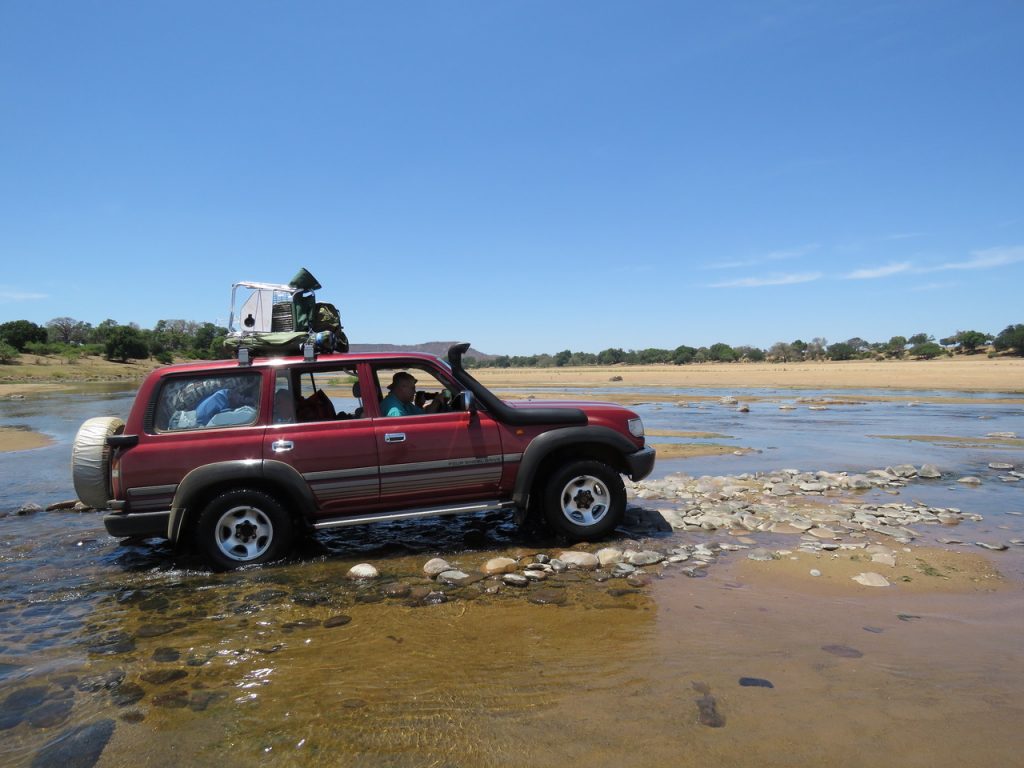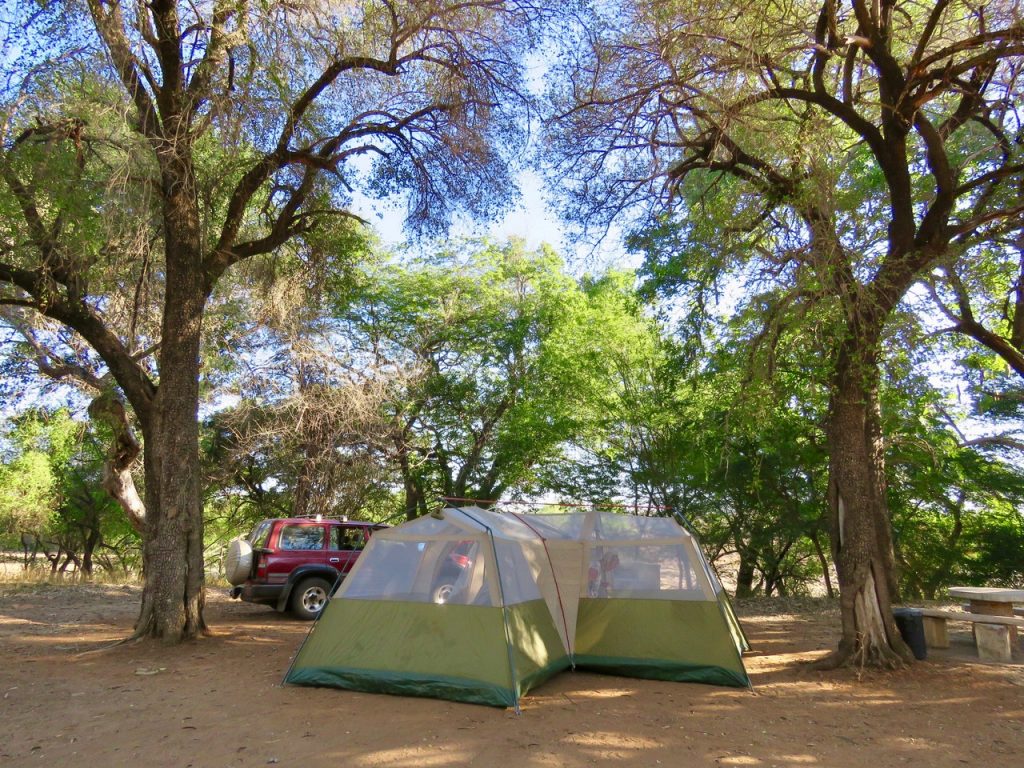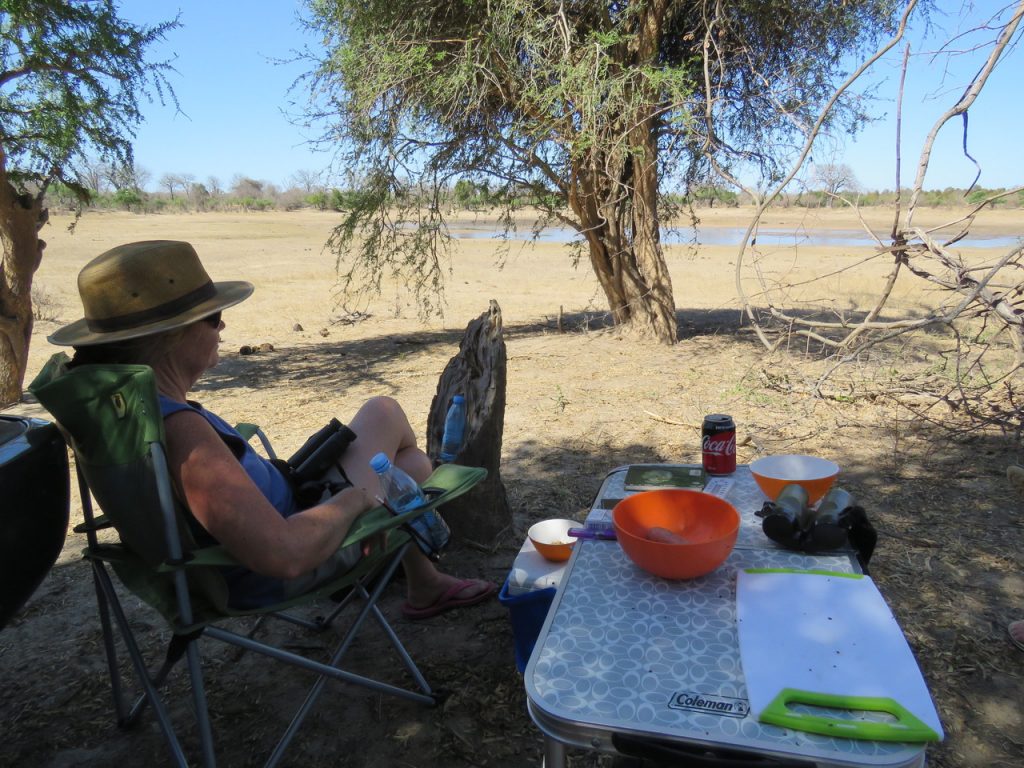Article: Debbie Swales

Having never been on a 24-hour game count, it was impossible to resist the offer from bush-lover friends, Andy, Jane and David, to venture into the depths of Gonarezhou National Park located in the south east of Zimbabwe.
Mark MacGregor, Chairman of the Midlands branch of WEZ (Wildlife and Environment Zimbabwe) and organizer of the game count, had allocated us Malihandava Pan on the far eastern edge of the park on the border with Mozambique. Luck had it that the pan was apparently dry, fuel was particularly scarce and therefore we were saved the 70 km drive to the middle of nowhere!
Our park adventure began at the Chipinda Pools entrance after a relatively easy 5-hour drive from Mutare. The first night was spent at Masasanya Dam, a short distance from Chipinda. The chalets, recently constructed by The Gonarezhou Conservation Trust (GCT) using local people from the nearby community, consist of simple rooms looking out onto the veranda where a small, well-stocked kitchen is situated and beyond, the dam. Divine home-made beds are covered in crisp white linen, feather duvets and soft pillows. Ablutions consist of an ‘ecoloo’ – a glorified long drop (but with no smell!) and a solar geyser supplies hot water to exceptionally well designed bucket showers.
We knew this may well be the end of our luxury accommodation but a job was to be done and the next morning we left at 7am, following the Runde River towards Chilojo Cliffs. The hoarse, raspy call of a leopard had woken me during the night and suddenly, just 30 metres off the road we had a magnificent sighting of a huge male leopard who posed for a while before melting away into the bush. Kudu bulls paraded on termite mounds allowing for spectacular photographic opportunities whilst elephant bulls meandered along their rocky paths up the hillsides in search of tastier morsels.

After a cooked brunch at the base of the dramatic Chilojo cliffs, we pressed on using the ‘boulder bridge’ through the Runde River and headed south. Roads in National Parks are often not very well sign posted but with common sense and a map bought from the Chipinda office, we wormed our way down the centre of the park, finally reaching our base for the next few nights, Mabalauta.
Mabalauta, situated on the banks of the Mwenezi River, is the headquarters of the southern section of the park. The campsite is surrounded by towering riverine trees and has recently been upgraded with solar showers, flush toilets, braai areas, concrete tables and seats.
Teams were based at either Mabaluata or exclusive campsites, some at the well appointed lodges at Swimuwini and others were allocated picnic sites along a 20km stretch of the Mwenezi River.
Lions roared all night and the wise old nyala bull remained in close proximity to our tent. The following morning, we loaded up what we needed for a game count, which isn’t much, and drove to Lion Pan.
On arrival, my first comment was, “How on earth am I going to sit still, looking at a pan, for 24 hours?” The thought was daunting but I pushed it aside. 24 hours later I wondered where on earth the time had gone. What a unique experience. Staying awake was barely an issue although we did take it in turns to snatch 2 hours of delectable sleep.

The 24 Hours
A troop of baboons wandered aimlessly around the watering hole but the rest of the afternoon was still and quiet and we wondered if anything was going to happen at this sludgy looking pan. We knew that elephants would not make an appearance unless coming for a mud bath, as fresh water and, lots of it, is preferred by these giants. Never a dull moment in Africa though, and we were fully entertained by thousands of doves flying in to drink. A calculating peregrine falcon smacked a dove with a loud thump, feathers flying, and in no time at all an opportunistic tawny eagle appeared only to be chased off by the peregrine.
Dusk arrived and with it, the flutter of wings and beautiful melodious gabble of double banded sandgrouse. As darkness set in, loud splashing alerted us and, peering through binoculars, we were able to make out the shapes of a few buffalo and with them, several zebras. Throughout the night, the task of identifying a steady trickle of thirsty animals kept us fully occupied. Prowling hyenas slunk around, peering sideways at us, jackal trotted by looking for an easy meal, the humorous gait and conceited attitude of honey badgers made us giggle as they lumbered along with absolutely no fear of anyone or anything. Spring hares with gangly, kangaroo-like legs loped around, competing for grazing with the scrub hares. Timid duiker, steenbok and grysbok appeared in the early hours between 1.30 and 3.30 a.m. when temperatures dropped to a chilling 14ºC. The cold and lack of sleep was a worthy excuse for whisky to be added to the numerous cups of coffee! At day break, the thousands of doves reappeared and stood cautiously drinking; their golden reflections shimmering against the thin layer of water on top of the pan. 12 noon suddenly arrived and, reluctantly, we put our binoculars away.
This is an extraordinary bush experience. No internet, no worries, no stress. Perhaps the only concern being that the ever present ka-ka-ka call of a yellow-billed hornbill can be hypnotizing and if you put your binoculars down to catch 40 winks you may miss something! The greatest challenge of all is identifying bird calls – and what a pleasurable task that is!
Results
The idea behind the game count is to collect data to establish wildlife numbers within the park. Static counts at water holes take place over a weekend closest to full moon and participation is voluntary using Society members.
This is the third count in Gonarezhou in recent years. The previous two covered Runde river only and had six and nine teams respectively. This year had 27 teams. The northern region had 14 teams and the southern, 13. This is the first time the entire park has been covered. Counts were done many years ago but records seem to have disappeared.
Preliminary results for 2018 indicate the highest body count was at Machaniwa Pan where one team counted 1015 individual animals over the 24hr period but the greatest number of species seen was at our pan, Lion Pan, with 20 species. Centre Pan recorded 18 and two others with 16 on Runde River downstream from Chipale and at Tembwahata.
Overview
During our 5 days in the park, we counted a total of 32 mammal species and 131 bird. A highlight of the trip being a small flock of 16 crested guinea fowl, fluffy topknots wafting in the breeze with darker, sleeker bodies than their counterparts the helmeted guinea fowl.
The Gonarezhou Conservation Trust has invested significantly in rejuvenating the north of the park and over the last year, the south. Malipati Safari area, across the Munezi River, (previously a hunting area) is now under direct management of the Trust who will also be investing in the rehabilitation of this section with exciting new developments in time to come.
WEZ Game Count Information:
Mark MacGregor: wezmid@gmail.com
Cell 0712864168 or 0771367617
For information on Gonarezhou Conservation Trust:
Visit: www.gonarezhou.org
FB: Gonarezhou National Park
Accommodation Bookings:
Gonarezhou is now managed through the Gonarezhou Conservation Trust, a partnership between Zimbabwe Parks and Wildlife Management Authority and Frankfurt Zoological Society.
All bookings are made directly with GCT teams in Chipinda and/or Mabalauta,
Tel: 0779 788 811 (Call and WhatsApp)
Email: reservations@gonarezhou.org
mpofu@gonarezhou.org (Area Manager)
